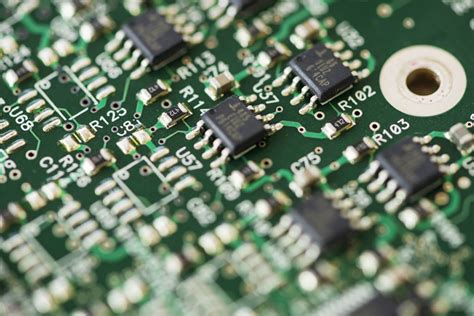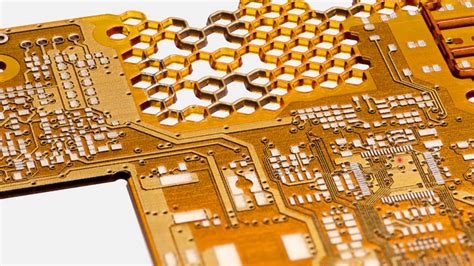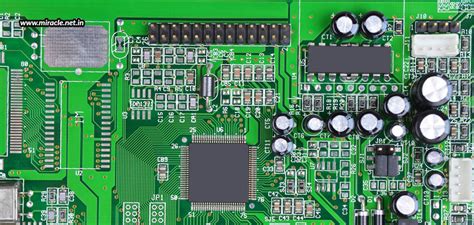The Evolution of PCBs in Electronics
The history of PCBs dates back to the early 1900s when they were first developed as a means to simplify the wiring of complex electronic circuits. Prior to the invention of PCBs, electronic components were connected using point-to-point wiring, which was a time-consuming and error-prone process. The introduction of PCBs allowed for the automation of the wiring process, making it faster, more reliable, and more cost-effective.
The Early Days of PCBs
The first PCBs were made using a process called “printed wiring,” which involved printing conductive ink onto an insulating substrate. These early PCBs were used primarily in military applications during World War II, where they proved to be more reliable and durable than point-to-point wiring. However, the printed wiring process was still relatively expensive and time-consuming, limiting the widespread adoption of PCBs in the electronics industry.
The Rise of Etched PCBs
In the 1950s, a new method for manufacturing PCBs was developed called “etching.” This process involved coating a copper-clad insulating substrate with a photoresist material, exposing it to light through a patterned mask, and then etching away the unwanted copper using an acid bath. This method allowed for the creation of much more complex and intricate circuit patterns, as well as the ability to mass-produce PCBs at a lower cost.
The Introduction of Multi-Layer PCBs
As electronic devices became more complex and required more components, the need for higher-density PCBs arose. In the 1960s, the first multi-layer PCBs were developed, which allowed for the stacking of multiple layers of conductive pathways separated by insulating material. This enabled the creation of even more complex circuits in a smaller footprint, further advancing the capabilities of electronic devices.
The Benefits of Using PCBs in Electronics
There are numerous reasons why PCBs have become the go-to choice for electronics manufacturers. Some of the key benefits of using PCBs include:
1. Compact Size
One of the main advantages of PCBs is their ability to accommodate a large number of components in a small space. This is particularly important in today’s electronics industry, where devices are becoming increasingly smaller and more portable. PCBs allow for the miniaturization of electronic circuits, enabling manufacturers to create compact and lightweight devices that can be easily carried around.
2. Reliability
PCBs are highly reliable compared to other methods of wiring electronic circuits. The conductive pathways on a PCB are etched onto the insulating substrate, which provides a stable and secure connection between components. This reduces the risk of short circuits, loose connections, and other issues that can cause electronic devices to fail.
3. Cost-Effectiveness
The use of PCBs in electronics has greatly reduced the cost of manufacturing electronic devices. PCBs can be mass-produced using automated processes, which reduces the amount of manual labor required and lowers production costs. Additionally, the use of standardized components and designs allows for economies of scale, further reducing the cost of production.
4. Improved Signal Integrity
PCBs are designed to minimize signal interference and ensure the integrity of the electrical signals passing through the circuit. The conductive pathways on a PCB are carefully designed to maintain a consistent impedance and reduce the risk of signal reflections and crosstalk. This is particularly important in high-speed and high-frequency applications, where signal integrity is critical to the performance of the device.
5. Ease of Assembly
PCBs simplify the assembly process for electronic devices by providing a standardized platform for mounting components. Components can be easily soldered onto the PCB using automated processes, reducing the amount of manual labor required and improving the consistency and reliability of the final product.

Common Types of PCBs Used in Electronics
There are several types of PCBs used in electronics, each with its own unique characteristics and applications. Some of the most common types of PCBs include:
Single-Layer PCBs
Single-layer PCBs are the simplest and most basic type of PCB. They consist of a single layer of conductive material, usually copper, etched onto an insulating substrate. Single-layer PCBs are typically used in simple, low-cost electronic devices such as toys and appliances.
Double-Layer PCBs
Double-layer PCBs have conductive material on both sides of the insulating substrate, with conductive pathways connecting the two layers through small holes called “vias.” Double-layer PCBs are used in more complex electronic devices, such as smartphones and laptops, where higher component density and more complex circuitry are required.
Multi-Layer PCBs
Multi-layer PCBs consist of multiple layers of conductive material separated by insulating layers. These PCBs can have anywhere from four to twenty or more layers, depending on the complexity of the circuit. Multi-layer PCBs are used in high-performance electronic devices, such as servers and medical equipment, where high component density and signal integrity are critical.
Flexible PCBs
Flexible PCBs are made using a flexible insulating substrate, such as polyimide, which allows the PCB to bend and flex without breaking. Flexible PCBs are used in applications where the electronic device needs to conform to a specific shape or where the PCB needs to move or flex during operation, such as in wearable electronics and automotive applications.
Rigid-Flex PCBs
Rigid-flex PCBs combine the benefits of both rigid and flexible PCBs by using a combination of rigid and flexible substrates. The rigid sections of the PCB provide structural support and stability, while the flexible sections allow for movement and flexibility where needed. Rigid-flex PCBs are used in applications where both high component density and flexibility are required, such as in aerospace and military electronics.

PCBs in Different Electronic Applications
PCBs are used in a wide range of electronic applications, from consumer electronics to industrial and military equipment. Some of the most common applications of PCBs in electronics include:
Consumer Electronics
PCBs are used in virtually every type of consumer electronic device, from smartphones and tablets to televisions and gaming consoles. In these applications, PCBs are used to interconnect the various components of the device, such as the processor, memory, and display, and to provide a stable and reliable platform for the device to operate on.
Industrial Electronics
PCBs are also widely used in industrial electronics, such as process control systems, automation equipment, and power electronics. In these applications, PCBs must be able to withstand harsh environmental conditions, such as extreme temperatures, vibration, and exposure to chemicals and moisture. Industrial PCBs are typically designed with more robust materials and construction techniques to ensure reliable operation in these demanding environments.
Medical Electronics
PCBs are used in a variety of medical electronic devices, from patient monitoring systems and diagnostic equipment to implantable devices and prosthetics. In these applications, PCBs must meet strict safety and reliability standards to ensure the safety and well-being of patients. Medical PCBs are often designed with special features, such as shielding and grounding, to minimize electromagnetic interference and ensure accurate and reliable operation.
Aerospace and Military Electronics
PCBs are used extensively in aerospace and military electronics, where reliability and performance are critical. In these applications, PCBs must be able to withstand extreme environmental conditions, such as high altitudes, radiation, and shock and vibration. Aerospace and military PCBs are often designed with special materials and construction techniques, such as the use of high-temperature laminates and conformal coatings, to ensure reliable operation in these demanding environments.

The Future of PCBs in Electronics
As electronic devices continue to evolve and become more complex, the role of PCBs in electronics is likely to become even more important. Some of the key trends and developments in the future of PCBs in electronics include:
Miniaturization
The trend towards miniaturization in electronics is likely to continue, with smaller and more compact devices becoming the norm. This will require the development of even smaller and more high-density PCBs, with more advanced manufacturing techniques and materials.
3D Printing
3D printing technology is already being used to create PCBs, and this trend is likely to accelerate in the future. 3D printing allows for the creation of complex, three-dimensional PCB structures that can accommodate more components in a smaller space. This could lead to the development of new types of electronic devices with unique form factors and capabilities.
Flexible and Stretchable PCBs
The development of flexible and stretchable PCBs is likely to continue, with new materials and manufacturing techniques being developed to create PCBs that can conform to any shape or surface. This could lead to the development of new types of wearable and implantable electronic devices, as well as new applications in robotics and other fields.
Sustainability
As concerns about sustainability and environmental impact continue to grow, the electronics industry is likely to place a greater emphasis on the development of more sustainable and eco-friendly PCBs. This could involve the use of biodegradable materials, the development of more energy-efficient manufacturing processes, and the implementation of recycling and disposal programs for used PCBs.
Frequently Asked Questions (FAQ)
1. What are the different types of PCBs used in electronics?
There are several types of PCBs used in electronics, including single-layer PCBs, double-layer PCBs, multi-layer PCBs, flexible PCBs, and rigid-flex PCBs. Each type of PCB has its own unique characteristics and applications, depending on the complexity and requirements of the electronic device.
2. What are the benefits of using PCBs in electronics?
The benefits of using PCBs in electronics include compact size, reliability, cost-effectiveness, improved signal integrity, and ease of assembly. PCBs allow for the miniaturization of electronic circuits, provide a stable and secure connection between components, reduce manufacturing costs, minimize signal interference, and simplify the assembly process.
3. What are some common applications of PCBs in electronics?
PCBs are used in a wide range of electronic applications, including consumer electronics, industrial electronics, medical electronics, and aerospace and military electronics. In these applications, PCBs are used to interconnect the various components of the device and provide a stable and reliable platform for the device to operate on.
4. What are some of the key trends and developments in the future of PCBs in electronics?
Some of the key trends and developments in the future of PCBs in electronics include miniaturization, 3D printing, flexible and stretchable PCBs, and sustainability. These trends are likely to lead to the development of new types of electronic devices with unique form factors and capabilities, as well as more sustainable and eco-friendly PCBs.
5. Why are PCBs so important in the electronics industry?
PCBs are important in the electronics industry because they provide a reliable, cost-effective, and efficient means of interconnecting electronic components and creating complex electronic devices. Without PCBs, electronic devices would be larger, less reliable, and more expensive to manufacture. PCBs have revolutionized the electronics industry and will continue to play a critical role in the development of new and innovative electronic devices in the future.
Conclusion
In conclusion, PCBs have become an essential component in the electronics industry, enabling the creation of compact, reliable, and cost-effective electronic devices. From consumer electronics to industrial and military applications, PCBs play a critical role in ensuring the functionality and performance of electronic systems. As the electronics industry continues to evolve and advance, the importance of PCBs is only likely to grow, with new materials, manufacturing techniques, and design innovations leading to even more advanced and capable electronic devices in the future.

Leave a Reply